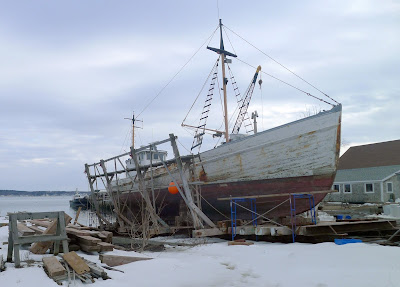 |
| Painting by student Marilyn Feinberg |
Color, light, and composition for outdoor painters
Carol L. Douglas
394 Commercial Street, Rockport
Starting April 4, 2017
10-1 AM Tuesdays, six week session
Fee: $200
Last month two friends took me to lunch at the Waterfront restaurant in Camden. As a bitter wind piled clouds high above the islands of Penobscot Bay, they put a question to me. “When will you stop slacking and start teaching weekly classes again?”
They’re right. My
trip to Canada had stretched into the holidays, which had then become a trip to the
Bahamas. I’ve been working hard, but not teaching.
They nailed me down to a commitment. Our next cycle of classes starts on Tuesday, April 4. That will be from 10-1 AM, in my studio at 394 Commercial Street, Rockport. If you’re interested, there are more details available on my website,
here.
The goal is intensive, one-on-one instruction that you can take back to your studio to apply during the rest of the week. We’ll cover issues like design, composition, and paint handling. We will learn how to mix and paint with clean color, and how to get paint on the canvas with a minimum of fuss.
And, yes, we’ll talk about drawing. If you ever want to paint anything more complicated than marshes, you must know how to draw. As
I’ve demonstrated before, any person of normal intelligence can draw; it’s a technique, not a talent. And it’s easy to learn, no matter what you’ve been led to believe.
 |
| Painting by student Jennifer Jones |
We’ll start in my studio, but on pleasant days, we’ll paint at outdoor locations. Painting outdoors, from life, is the most challenging and instructive exercise in all of art. It teaches you about light, color and composition.
That, of course, limits the media you work in to oils, watercolor, acrylics, or pastel, since they’re what is suitable to outdoor painting.
Years ago, a friend kept asking me to give painting lessons. “I don’t know how to do that,” I’d answer. We went round and round for several years. Eventually, I caved. Three people signed up. I figured I’d teach one session and they’d realize I was clueless. My studio was on the third floor. I was the model and the instructor and I kept hitting my head on the ceiling as I moved around the room.
Turns out, I wasn’t actually that bad. From there I moved into a nicer room above the garage and enlarged my teaching practice. I started teaching workshops and concentrating on
plein air instruction, since that’s what I love best. When I left Rochester, I left a large circle of students behind. You can see a small sample of their work
here. One of my great joys is that they formed a group,
Greater Rochester Plein Air Painters, and continue to paint together.
“You used to teach on Saturdays,” a student recently pointed out. That’s true, I realize. If you want to study with me but work during the week, let me know. If I have three people interested, I’ll offer a weekend class.

























